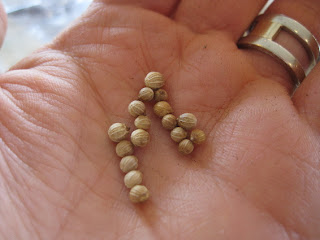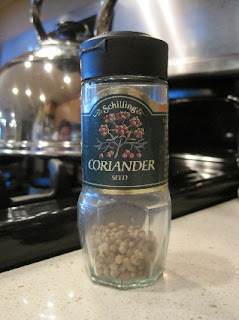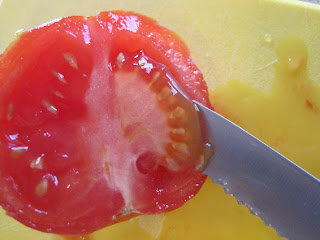But standing before those glorious seed racks, I become transfixed by the perky packets. I listen intently to their promising rattle, and gaze at their colorful, come-hither pictures. One packet shows me peas bursting from their pod. Another, plump tomatoes clinging to a vine. Somehow, I come to believe these envelopes contain a special magic, some rare substance whose provenance is distant, romantic, and charmingly agrarian.
It’s only once I’m home, shaking the seeds into my palm, that the spell breaks. Then I stare, in quiet disbelief, as a simple question crowds my mind:
Did I really think tomato seeds from a packet would look any different from the ones on my plate?
Another open envelope leads to another, alarmingly-obvious realization:
Pea plants are grown from… well… dried out peas!
And finally:
Why did I just spend $2 on a packet of coriander seeds when I have a jar of them in my spice drawer?
The disconnect is as ridiculous as it is real. Part of me is embarassed, and another part says, well, can you blame me? I can’t be the only gardener ever to have fallen into this bizarre trap-- what I've come to think of as the Vortex of Consumer Kitchen Gardening.
When you’re in the vortex, it seems like the “stuff” of starting a vegetable garden is some “special stuff” you can only get from a store, rather than the “ordinary stuff” your kitchen happens to be filled with already.
Though I don’t know how this disconnect happens, I imagine grocery stores have something to do with it. After all, when produce is piled, Wharhol-like, in neat, monochromatic stacks, it suddenly becomes a strange object unto itself, a beautiful article of food, rather than something that was ever connected to a plant, or a field, or a seed.
 |
| Credit: dreamstime.com |
As for me, I took one look at those tomato seeds from the packet, and instantly knew what I had to do. After planting the Better Bush seeds that cost $3.49 for the envelope (from which I only used 6 seeds,which were thinned down to two plants.) I grabbed the last soft Campari tomato from our kitchen fruit bowl and sliced.
I mean, what did I have to lose?
I removed the seeds, let them dry out on a paper towel, then pushed them into a peat soil pellet. I placed them, in a baggie, under the lights with my other seedlings.
A few days later I had this.
Today, after thinning and repotting into a 4 inch peat pot, my kitchen tomato plant looks like this:
After doing a minimal amount of web research, I’ve found there is some debate as to whether Campari tomatoes from the market can be mined for seeds and grown at home. Some claim that, because it’s a hybrid tomato, it won’t produce a true copy of itself from seed. But at least one other gardener has claimed success as you see here.
If it works, it really provides some food for thought, so to speak. After all, a container of Campari tomatoes costs roughly the same as the envelope of tomato seeds, and contains far more seeds. And since I buy the tomatoes already, the seeds actually cost nothing.
But seeing those tomato sprouts gave me all sorts of other ideas.
Here’s my infant Gala apple tree, sprouted from a seed I plucked out of an organic apple before eating it.
If this sprout succeeds, I think I’ll pot it up along with my Arbor Day Foundation trees.
Then I started thinking about the Organic sweet peppers I pay $4 per package for.
Yum, right? Seeds from these took a while to germinate, but if you look closely, you can see the greenish/purplish stem emerging.
The only factor that might rain on my produce parade is our relatively short growing season in Northern Nevada. If these babies require many, many months of warmth and sun before producing a harvest, I could be in trouble. I’ll keep you posted.
Any readers out there have successes or failures to share after using kitchen seeds in your garden?











The only thing I've ever used is potatoes which I've heard you should never use. Apparently commercial potatoes are sprayed with a chemical to stop them from sprouting but my mother for years used grocery store potatoes to grow her plants and so did I. Never had a problem.
ReplyDeleteI love it! Your post made me chuckle...as I have certainly fallen into the vortex before. :) I've never tried saving seed from my grocery store purchases, but it's worth a shot! I did try planting garlic one year, but managed to forget about it and accidentally dug it up. Oooops. :)
ReplyDeleteBesides whatever mysterious fungus is growing on the cucumbers that I forgot about in my produce drawer, no, sadly, I always start so late in the season that I have to buy plants--"Next Year, I'll start earlier." My favorite chant.
ReplyDeleteMy husband started doing this recently. Which makes perfect sense. In fact, when you finally figure it out, you feel like a complete moron. But he is kind of driving me nuts because he dries all of his seed out on our saucers and then leaves them around the kitchen. And then expects me to not throw them away. Because I don't have enough to think about. . .
ReplyDeleteMarguerite: I've heard the same thing about potatoes. I've also heard that conventionally grown potatoes are one of the items of produce that farmers themselves won't consume because they know how much crap they spray on them. I've started buying organic, and they do sprout more, so I keep them in the fridge. I'm sure they'd make great starts, too.
ReplyDeleteHanni: Haven't tried garlic yet, though we are HUGE garlic eaters. Perhaps I should.
I've started lots of kitchen food: beans, peas, potatoes, garlic, tomatoes, peppers, celery, dill, fennel, squash, cukes, zukes, pumpkin, cilantro (coriander), etc. The only reason I buy veg seeds (if I haven't saved any from my own home grown) is to get the size/shape/flavor/properties I want. Or try new varieties. Kitchen foods can be hybridized and not always true to the original item. The best fun I had one year was when I planted raw peanuts...
ReplyDeleteKris: You are an old pro. Nice....
ReplyDeleteI also use seeds from my fruits and vegetables. I have several lemon, lime, and grapefruit trees growing as I write. However, I am having trouble with the Campari tomatoes, all other sprouted but not the Campari. I dried, froze and planted the seeds. I dried, planted the seeds...either way no luck.I am however having very good luck with Arkansas Traveler tomaotes which I brought seed from Fort Smith, AR to Destin, Florida.
ReplyDeletelouis vuitton, longchamp pas cher, oakley sunglasses, louboutin outlet, replica watches, oakley sunglasses, louis vuitton, nike free, louis vuitton, ugg boots, oakley sunglasses, ray ban sunglasses, longchamp, ray ban sunglasses, cheap oakley sunglasses, kate spade outlet, prada outlet, polo ralph lauren outlet, louis vuitton outlet, longchamp outlet, replica watches, louboutin, christian louboutin outlet, air max, gucci outlet, air jordan pas cher, nike roshe run, oakley sunglasses, tory burch outlet, ralph lauren pas cher, nike air max, jordan shoes, nike air max, louis vuitton outlet, polo ralph lauren outlet, prada handbags, michael kors, uggs on sale, chanel handbags, louboutin shoes, ray ban sunglasses, nike outlet, longchamp outlet, tiffany jewelry, nike free, louboutin pas cher, sac longchamp, ugg boots, tiffany and co, burberry
ReplyDeletehttp://www.prokr.net/2016/09/cleaning-companies-17.html
ReplyDeletehttp://www.prokr.net/2016/09/cleaning-companies-29.html
http://www.prokr.net/2016/09/cleaning-companies-28.html
http://www.prokr.net/2016/09/cleaning-companies-27.html
http://www.prokr.net/2016/09/cleaning-companies-26.html
http://www.prokr.net/2016/09/cleaning-companies-25.html
http://www.prokr.net/2016/09/cleaning-companies-24.html
navigate to this websitevisit the site find more infothis hyperlink Check This Outcompany website
ReplyDelete